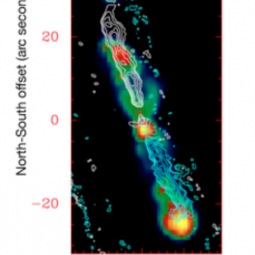Scientists on board NASA’s flying telescope, the Stratospheric Observatory for Infrared Astronomy, or SOFIA, caught sight of roiling material streaming from a newly formed star, which could spark the birth of a new generation of stars in the surrounding gas clouds.
Many stars in the early stages of formation expel large amounts of super-heated material in two streams, known as bipolar outflows or jets, which flow in opposite directions. A team of scientists led by Bertrand Lefloch from the University of Grenoble Alpes, France, observed these jets coming from Cepheus E, a massive protostar at the earliest stage of star formation, located 2,400 light years from Earth in the constellation Cepheus. Lefloch’s team is studying how such outflows originate and the effects those jets have on star formation in the surrounding clouds.
“The SOFIA observations have unveiled new clues to how these jets powered by protostars actually form, and clarified the physical conditions reigning in these objects,” Lefloch said. Lefloch’s team has determined that the jets are less than 1,000 years old, making this process astronomically very young. The powerful jets are shown to extend out to a distance of 118 billion miles and the jet material is moving at speeds between 200,000 and 300,000 mph.
The team’s observations were made using SOFIA’s Upgraded German Receiver at Terhertz Frequencies, upGREAT, to make a map of the hottest and densest portions of the matter ejected from Cepheus E. The researchers identified three main parts of the outflow: the jet itself, regions of the surrounding gas and dust cloud through which the jets have plowed through, and the shock waves at the farthest ends of the jets affecting the surrounding cloud.
The last area is of particular interest, in that it could be the future birthplace of additional stars. The formation of new stars is thought to be triggered by these shocks. The team was able to map the hottest material because of the unique wavelength range available to SOFIA and the upGREAT instrument. The maps also contained more detail than other observatories because of the size of SOFIA’s telescope.
“The upGREAT instrument now has more detectors, allowing us to make more detailed maps of celestial gas molecules very rapidly,” said Universities Space Research Association’s SOFIA Science Mission Director Harold Yorke. “The physical conditions in the outflowing gas are still poorly known, and we are just now employing new instruments enabling us to study this process. These observations demonstrate that SOFIA is a powerful tool to map the areas around star-forming regions, providing data that are helping to develop a more comprehensive picture of star formation.”
Astronomers are excited about these SOFIA observations because they provide high-resolution data that are complemented by observations conducted by ground and space-based telescopes, including the Atacama Large Millimeter Array, ALMA, and the Herschel Space Observatory . Results from the team’s observations were published in the journal Astronomy and Astrophysics . Further investigations of this target will be necessary to definitively determine how this violent activity impacts star formation.
Technical Information on SOFIA Observations
SOFIA is a Boeing 747SP jetliner modified to carry a 100-inch diameter telescope. It is a joint project of NASA and the German Aerospace Center, DLR. NASA’s Ames Research Center in California’s Silicon Valley manages the SOFIA program along with science and mission operations in cooperation with the Universities Space Research Association headquartered in Columbia, Maryland, and the German SOFIA Institute (DSI) at the University of Stuttgart. The aircraft is based at NASA Armstrong Flight Research Center's Hangar 703, in Palmdale, California.
Points of Contact
Nicholas A. Veronico
NVeronico@sofia.usra.edu
SOFIA Science Center
NASA Ames Research Center, Moffett Field, California
